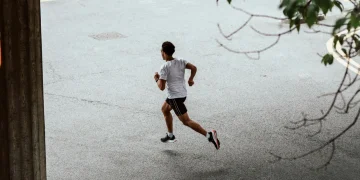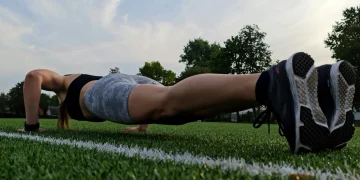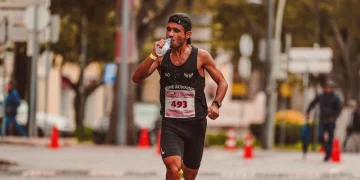To achieve your running goals without injury, you have to strengthen the whole body and keep it flexible. During running, the shoulders and upper back are often pinched. If you are a professional runner, you also know that ligaments and muscles can hurt after hard training.
Yoga for runners is an excellent tool to help get rid of the aches and pains listed above and recover from injuries. Moreover, it helps with mental health.
These facts are successfully proven by scientific research. According to a National Library of Medicine study, Thai yoga training improves body flexibility and mobility of ligaments and joints. Bikram yoga stimulates beneficial changes in musculoskeletal fitness. Yoga asanas help strengthen the core, quadriceps, hamstrings, and hip flexors.
In short, yoga improves endurance which is so crucial for runners. And one of the most valuable benefits – yoga teaches how to use breathing as a tool. This is very important, especially if you are preparing for a long marathon.
There is also a lot of research proving that yoga supports mindfulness, healthy eating, and quality sleep. Many runners love yoga because it helps reduce fatigue and stress and improves concentration and memory. Besides, such training helps runners to recover faster and prevents running injuries, making it irreplaceable for half marathon recovery.
What do You Need to Know Before Starting Yoga?
First, you can feel some discomfort at the start. It is ok because your body is getting used to a new exercise. Don’t try to train through the pain. Your moves must be easy and smooth. If you do everything right, you’ll quickly notice positive changes in your training (you will run better with yoga) and the quality of your daily life.
How Many Times a Week Should I Do Yoga?
There is no universal answer to this question since the frequency of yoga training depends on the individual. In general, runners should aim to do yoga at least twice a week, preferably more often if possible. If you are a beginner, two times is enough. If you are already an advanced runner and your goal is recovery or preparation for the race, practice yoga at least four times a week.
We have chosen the top poses to strengthen your core, add speed, help relieve pain during and after runs, and make you more resilient. You can do them at home on rest days or immediately after training.
TOP 10 yoga Poses for Runners
1. Butterfly (Baddha Konasana)
This popular asana develops flexibility and mobility of hip joints and is often used as recovery yoga for runners. Baddha Konasana is very easy to do but has a tremendous healing effect. This pose prevents radiculitis, osteochondrosis, and spinal and thoracic hernias. It also increases the tone of the blood vessels of the lower extremities, thus eliminating the symptoms of varicose veins.
2. Happy Baby (Ananda Balasana)
Ananda Balasana is excellent for relaxation. It also helps to stretch the muscles of the hips, knees, and elbows, as well as the spine, shoulders, and neck. Many coaches recommend Happy Baby for runner recovery yoga. The back, shoulders, and neck are relaxed in different ways with each variation of the pose. Try all of them and choose the best one for you to relax certain muscle groups.
3. Pigeon (Eka Pada Rajakapotasana)
This pose is perfect if you are looking for good yoga stretches for runners. Eka Pada Rajakapotasana helps develop flexibility of the spine and relieves tension in the muscles of the thighs. It also helps stretch the entire front surface of the body: ankles, hips, groin, abdomen, chest, and throat, and lengthens the deep hip flexor muscles. An asana liberates the sacrum, which is so useful for runners, as the sacrum accumulates the tension. Eka Pada Rajakapotasana also improves posture and opens the chest and shoulder girdle. We highly recommend you include asana in your strength training program.
4. Downward Dog (Adho Mukha Svanasana)
The downward dog is designed to strengthen the arms, shoulders, and back, as well as the hamstrings, calves, and arches of the feet. This asana is especially useful in post-run yoga. It ensures the lightness of the legs and relieves pain in the heels. Performing this asana strengthens the calf muscles and helps relieve tension from the shoulder joints.
5. Cow Face Pose (Gomukhasana)
This yoga pose opens the hip joint. Runners like this pose because it improves the mobility of the hip joint and provides elasticity to the hip, shoulder, and calf muscles.
The benefit of Cow Face Pose is as follows: crossed legs increase blood circulation in the muscles and joints of the legs, relieving tension and improving mobility. And this, in turn, improves the work of the lower spine.
6. Bridge (Setu Bandha Sarvangasan)
This pose is highly recommended if you ask yourself how to recover from a marathon. The bridge is designed to stretch the chest, back, and neck muscles. This asana strengthens the back and hamstring muscles. It also reinforces the cervical spine and provides a lumbar tone and sacrum, strengthening the back muscles and thighs. The opening of the shoulders, chest, and back allows you to regulate your breathing better and develop good posture.
7. Elongated Triangle Pose (Utthita Trikonasana)
Utthita Trikonasana is one of the best yoga poses for runners. It tones the leg muscles, strengthens the ankles and knees, and helps maintain the mobility of the hip joints. It is also very useful for getting rid of pain in the back and neck.
Correct execution of the Elongated Triangle Pose will teach you to control the hip joints and align their position. The correct position of the pelvis affects the rest of the spine, removing clamps in the back. We recommend you add Utthita Trikonasana to your marathon training plan.
8. Warrior III (Virabhadrasana III)
Let’s talk about good yoga poses for legs. Warrior III is one of the best as it strengthens the muscles of the lower back and legs and gives firmness and a beautiful shape to the leg muscles.
Warrior III is a perfect yoga for runner’s knee. It helps to restore the mobility of the knees and their ability to bear loads. It also strengthens the hamstring muscles, which is especially useful during recovery after injuries.
9. Tree Pose (Vrksasana)
This pose is great to include in yoga stretching for runners. It extends the hips, shins, and spine. Tree pose perfectly trains the nervous system, which handles balance, coordination, posture, and muscle tone.
This pose helps strengthen leg ligaments and the back, improving posture. And the muscles of the shins and feet relax, increasing blood circulation in the lower parts of the legs. So, if you want to try some running yoga, we recommend you to try this position first.
10. Chaturanga Dandasana (Four-Limbed Staff Pose)
Chaturanga Dandasana is a powerful yoga pose that strengthens the muscular corset. The pose is essentially a low plank exercise. Despite the simplicity of execution, the benefits of this asana are incredible: it strengthens the muscles of the legs, arms, shoulders, abs, back, and wrists, and the muscular corset. It also helps support the spine, making Four-Limbed Staff Pose one of the best yoga stretches. Try to do it 2-3 times a week, and soon you will see significant changes in your running and wellness.
Should Runners Do Yoga?
As you can see, yoga and running go hand in hand. Regular yoga improves running performance, strengthens muscles and joints, helps prevent injuries, and calms the nervous system. We can talk about the benefits of yoga for runners, but it is better to try and add some asanas to your marathon training plan and see the positive effects with your own eyes.






